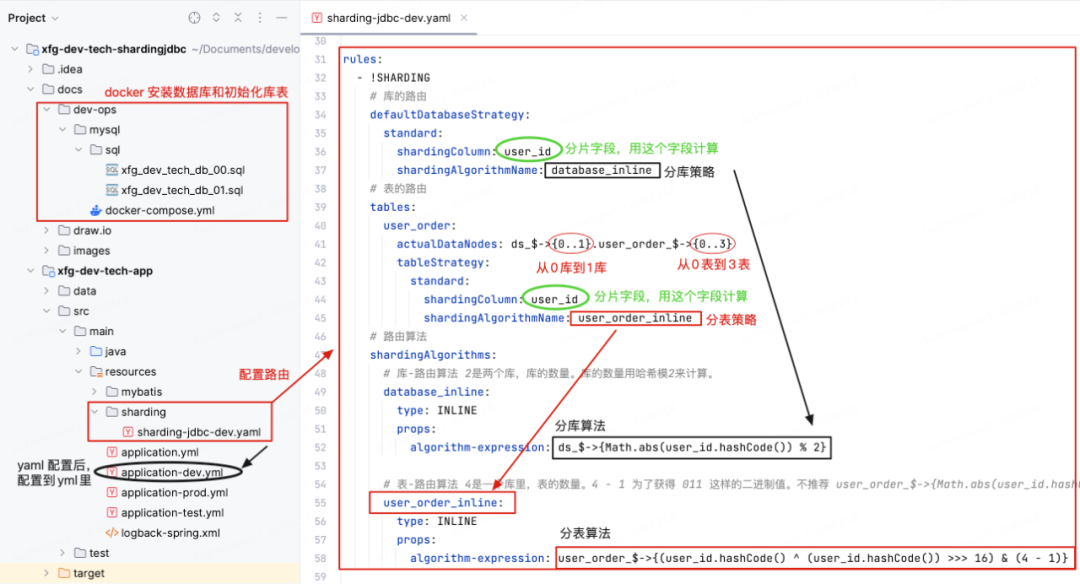面试问:“你为啥自研路由组件,咋不用sharding-jdbc”
面试问:“你为啥自研路由组件,咋不用sharding-jdbc”

小傅哥
发布于 2023-11-03 16:52:37
发布于 2023-11-03 16:52:37
作者:小傅哥 博客:https://bugstack.cn
❝沉淀、分享、成长,让自己和他人都能有所收获!😜 ❞
面试问:“你为什么要自研,市面不是有吗,怎么回答?” 可以从以下3个点解答;
- 维护性;市面的路由组件比如 shardingsphere 但过于庞大,还需要随着版本做一些升级,市面上已经有很多版本了。而我们需要更少的维护成本。
- 扩展性;结合自身的业务需求,我们的路由组件可以分库分表、自定义路由协议,扫描指定库表数据等各类方式。研发扩展性好,简单易用。
- 安全性;自研的组件更好的控制了安全问题。当然,我们的组件主要是为了更好的适应目前系统的诉求,所以使用自研的方式处理。甚至各个大厂也都自研一整套分布式服务,来让自己的系统更加稳定可控。
接着问,你们为什么分库分表?
我们分库分表用的非常熟。但不能为了等到系统到了200万数据,才拆。那么工作量会非常大 我们的做法是,因为有成熟方案,所以前期就分库分表了。但,为了解释服务器空间。所以把分库分表的库,用服务器虚拟出来机器安装。这样即不过多的占用服务器资源,也方便后续数据量真的上来了,好拆分。
同时,Xxx系统,是瞬时峰值较高的系统,历史数据不一定多。所以我们希望,用户可以快速的检索到个人数据,做最优响应。因为大家都知道,Xxx这东西,push发完,基本就1~3分钟结束,10分钟人都没了。所以我们这也是做了分库分表的理由。
不过用和不用是一方面,会和不会是另外一方面。不能因为不会所以不用,不用是因为不同场景的所需。像 Apache ShardingSphere 在很多大的场景还是非常好用的,所以我们需要学习积累。积累不同的思想和设计,以及积累技术的运用。
本文的宗旨在于通过简单干净实践的方式教会读者,快速 Easy 的使用上 sharding-jdbc 这个笨重的大家伙!—— 这篇文章并不复杂,但市面上的案例,还真的很少有能拿过来就能运行起来的!
之所以说"笨重",是因为 Apache ShardingSphere 不只是简单意义上的路由组件,而是一款分布式 SQL 事务和查询引擎,可通过数据分片、弹性伸缩、加密等能力对任意数据库进行增强。同时它又在迭代过程中,衍生出了很多的版本,以及对应了不同的使用方式。并在 ShardingSphere 5.3 以后又做了不小的架构调整。所以很多伙伴在使用的时候,经常是找了一上午的资料,到下午下班还没对接上。
本文涉及的工程:
- xfg-dev-tech-shardingjdbc:https://gitcode.net/KnowledgePlanet/road-map/xfg-dev-tech-shardingjdbc
- 官网:https://shardingsphere.apache.org/index_zh.html
一、路由本质
分库分表的本质是数据的散列,分摊数据库资源压力。如把原本在一台机器上的数据库存放1000万数据,分摊到n台机上,拆分这1000万的数据和后续的增量。让每个数据库资源来分摊原本需要一台数据库所提供的服务。

- 当使用分库分表以后,并确定如使用
用户ID作为路由分片键。那么所做的CRUD操作,都是需要使用到这个用户ID,并根据ID做路由库表计算。 - 在大厂中,开发项目。并不会说目前这个业务需求规模不大,就不使用分库分表,而是分库分表都是非常成熟的方案,并不会因为使用了就降低很大的开发效率。所以基本就是默认就使用了。
- 那么使用了分库分表,就会很占用资源吗。也不会,因为刚开始业务体量不大的时候,都是虚拟机交叉使用,你的1台物理机虚出来10个虚拟机,大家交叉使用主备。这样你只是使用了分库分表,但库表的实际资源没占用那么多。
二、使用案例
- jdk 1.8 +
- ShardingSphere 5.4.1
<!-- https://mvnrepository.com/artifact/org.apache.shardingsphere/shardingsphere-jdbc-core -->
<dependency>
<groupId>org.apache.shardingsphere</groupId>
<artifactId>shardingsphere-jdbc-core</artifactId>
<version>5.4.1</version>
</dependency>
<!-- https://mvnrepository.com/artifact/org.yaml/snakeyaml -->
<dependency>
<groupId>org.yaml</groupId>
<artifactId>snakeyaml</artifactId>
<version>1.33</version>
</dependency>
- 因为需要解析 yaml 但默认的 SpringBoot 提供版本不支持 shardingsphere-jdbc-core 使用。
1. 工程结构

- 工程中,提供了 docker 配置数据库环境操作,并提供了对应的建表测试语句。如果你本机已经安装了数据库,那么只做库表语句导入以及 yml 配置数据库连接信息就可以。
- sharding-jdbc-dev.yaml 配置了详细的分库分表路由信息,在 algorithms 下配置的是库表的路由算法。这里的算法要根据实际自己使用中库表数量来设置&设计,避免发生较大的数据偏移。
- 配置完 sharding-jdbc-dev.yaml 需要在 application-dev.yml 中配置上 sharding-jdbc-dev.yaml 路径,这样才能正确加载。
- 如果你还需要定义出自己特定的路由算法,它还支持自己写个实现类的方式处理。
2. 算法配置
sharding/sharding-jdbc-dev.yaml
# https://shardingsphere.apache.org/index_zh.html
mode:
# 运行模式类型。可选配置:内存模式 Memory、单机模式 Standalone、集群模式 Cluster - 目前为单机模式
type: Standalone
dataSources:
ds_0:
dataSourceClassName: com.zaxxer.hikari.HikariDataSource
driverClassName: com.mysql.cj.jdbc.Driver
jdbcUrl: jdbc:mysql://127.0.0.1:13306/xfg_dev_tech_db_00?useUnicode=true&characterEncoding=utf8&autoReconnect=true&zeroDateTimeBehavior=convertToNull&serverTimezone=UTC&useSSL=true
username: root
password: 123456
connectionTimeoutMilliseconds: 30000
idleTimeoutMilliseconds: 60000
maxLifetimeMilliseconds: 1800000
maxPoolSize: 15
minPoolSize: 5
ds_1:
dataSourceClassName: com.zaxxer.hikari.HikariDataSource
driverClassName: com.mysql.cj.jdbc.Driver
jdbcUrl: jdbc:mysql://127.0.0.1:13306/xfg_dev_tech_db_01?useUnicode=true&characterEncoding=utf8&autoReconnect=true&zeroDateTimeBehavior=convertToNull&serverTimezone=UTC&useSSL=true
username: root
password: 123456
connectionTimeoutMilliseconds: 30000
idleTimeoutMilliseconds: 60000
maxLifetimeMilliseconds: 1800000
maxPoolSize: 15
minPoolSize: 5
rules:
- !SHARDING
# 库的路由
defaultDatabaseStrategy:
standard:
shardingColumn: user_id
shardingAlgorithmName: database_inline
# 表的路由
tables:
user_order:
actualDataNodes: ds_$->{0..1}.user_order_$->{0..3}
tableStrategy:
standard:
shardingColumn: user_id
shardingAlgorithmName: user_order_inline
# 路由算法
shardingAlgorithms:
# 库-路由算法 2是两个库,库的数量。库的数量用哈希模2来计算。
database_inline:
type: INLINE
props:
algorithm-expression: ds_$->{Math.abs(user_id.hashCode()) % 2}
# 表-路由算法 4是一个库里,表的数量。4 - 1 为了获得 011 这样的二进制值。不推荐 user_order_$->{Math.abs(user_id.hashCode()) % 2} 作为表的路由
user_order_inline:
type: INLINE
props:
algorithm-expression: user_order_$->{(user_id.hashCode() ^ (user_id.hashCode()) >>> 16) & (4 - 1)}
props:
# 是否在日志中打印 SQL。
# 打印 SQL 可以帮助开发者快速定位系统问题。日志内容包含:逻辑 SQL,真实 SQL 和 SQL 解析结果。
# 如果开启配置,日志将使用 Topic ShardingSphere-SQL,日志级别是 INFO。false
sql-show: true
# 是否在日志中打印简单风格的 SQL。false
sql-simple: true
# 用于设置任务处理线程池的大小。每个 ShardingSphereDataSource 使用一个独立的线程池,同一个 JVM 的不同数据源不共享线程池。
executor-size: 20
# 查询请求在每个数据库实例中所能使用的最大连接数。1
max-connections-size-per-query: 1
# 在程序启动和更新时,是否检查分片元数据的结构一致性。
check-table-metadata-enabled: false
# 在程序启动和更新时,是否检查重复表。false
check-duplicate-table-enabled: false
- mode:运行模式,默认就单机模式。
- dataSources:数据库连接信息。
- rules:路由算法。defaultDatabaseStrategy 库的路由、tables 表的路由。之后在 shardingAlgorithms 中配置具体的路由算法。这里的名称都是关联的,不要配置错。
- props:一些属性信息,包括是否打印日志等。
与这个对比,如果你使用的路由功能并不那么大,其实自研会更加简单。当然你也可以想办法,简化 sharding-jdbc 的配置。
3. 配置引入
application-dev.yml
spring:
datasource:
driver-class-name: org.apache.shardingsphere.driver.ShardingSphereDriver
url: jdbc:shardingsphere:classpath:sharding/sharding-jdbc-dev.yaml
- 和之前的一些 sharding 版本不同,这里是需要使用具体的 ShardingSphereDriver 和 url 地址,才能加载上我们配置的路由信息。
三、测试验证

- 基于工程中 docs/dev-ops/mysql/sql 创建库表。已经提供了库名、表和测试数据。
- 无论你使用哪种方式,都可以安装MySql 并使用可视化工具链接。这里小傅哥用的是 Sequel Ace
1. 写入数据
@Test
public void test_insert() {
for (int i = 0; i < 1000; i++) {
UserOrderPO userOrderPO = UserOrderPO.builder()
.userName("小傅哥")
.userId("xfg_" + RandomStringUtils.randomAlphabetic(6))
.userMobile("+86 13521408***")
.sku("13811216")
.skuName("《手写MyBatis:渐进式源码实践》")
.orderId(RandomStringUtils.randomNumeric(11))
.quantity(1)
.unitPrice(BigDecimal.valueOf(128))
.discountAmount(BigDecimal.valueOf(50))
.tax(BigDecimal.ZERO)
.totalAmount(BigDecimal.valueOf(78))
.orderDate(new Date())
.orderStatus(0)
.isDelete(0)
.uuid(UUID.randomUUID().toString().replace("-", ""))
.ipv4("127.0.0.1")
.ipv6("2001:0db8:85a3:0000:0000:8a2e:0370:7334".getBytes())
.extData("{\"device\": {\"machine\": \"IPhone 14 Pro\", \"location\": \"shanghai\"}}")
.build();
userOrderDao.insert(userOrderPO);
}
}
- 测试数据写入,你可以写入1000条数据,观察散列效果。并可以在这个过程中,调试修改 sharding-jdbc-dev.yaml 文件对库表路由的计算方式。
2. 查询数据
@Test
public void test_selectByUserId() {
List<UserOrderPO> list = userOrderDao.selectByUserId("xfg_PrmgwQ");
log.info("测试结果:{}", JSON.toJSONString(list));
}
- 查询的用户ID是已经写入到数据库表里的数据,查询的时候会根据用户ID继续路由计算。
3. 散列算法
@Test
public void test_idx() {
for (int i = 0; i < 50; i++) {
String user_id = "xfg_" + RandomStringUtils.randomAlphabetic(6);
log.info("测试结果 {}", (user_id.hashCode() ^ (user_id.hashCode()) >>> 16) & 3);
}
}
- 你可以尝试验证和编写新的散列算法,最终目的都是让数据尽可能散列到库表。
本文参与 腾讯云自媒体同步曝光计划,分享自微信公众号。
原始发表:2023-11-03,如有侵权请联系 cloudcommunity@tencent.com 删除
评论
登录后参与评论
推荐阅读
目录

